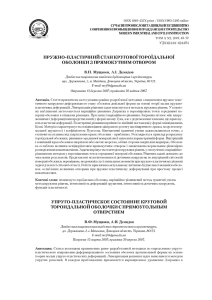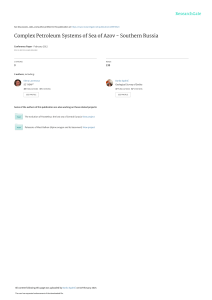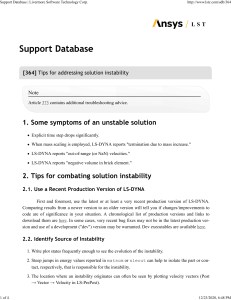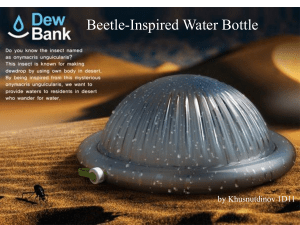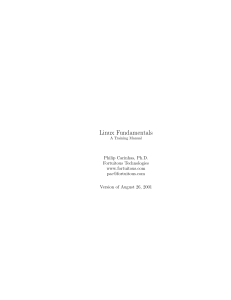conchological variability of anadara inaequivalvis
advertisement
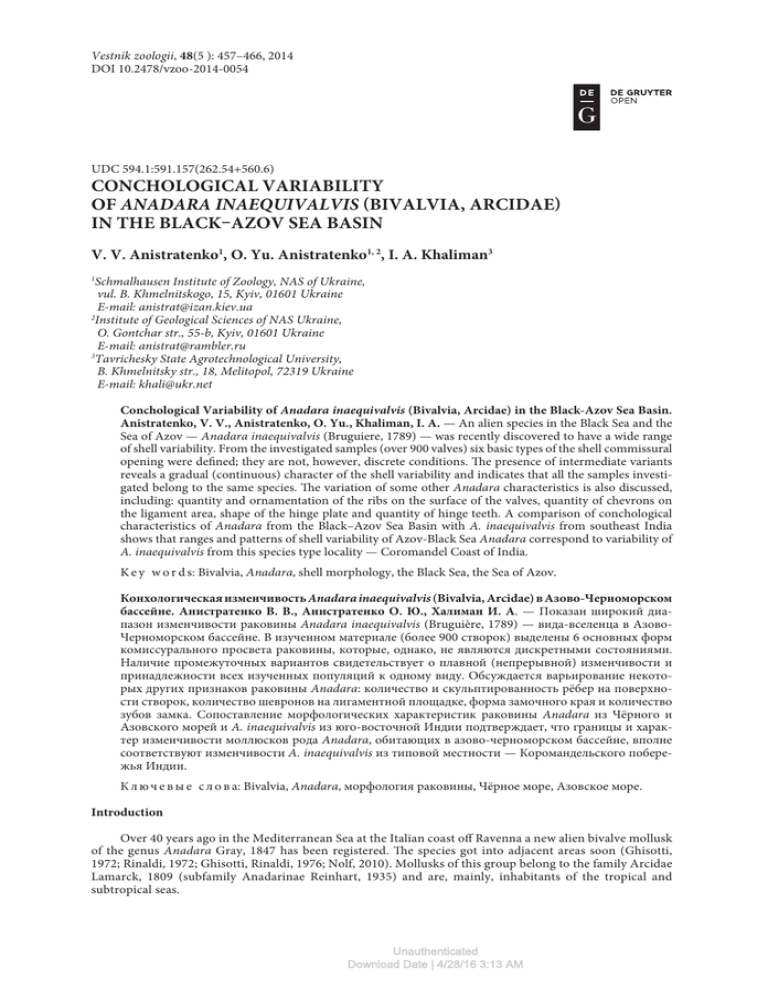
Vestnik zoologii, 48(5 ): 457–466, 2014 DOI 10.2478/vzoo-2014-0054 UDC 594.1:591.157(262.54+560.6) CONCHOLOGICAL VARIABILITY OF ANADARA INAEQUIVALVIS (BIVALVIA, ARCIDAE) IN THE BLACK–AZOV SEA BASIN V. V. Anistratenko1, O. Yu. Anistratenko1, 2, I. A. Khaliman3 1 Schmalhausen Institute of Zoology, NAS of Ukraine, vul. B. Khmelnitskogo, 15, Kyiv, 01601 Ukraine E-mail: anistrat@izan.kiev.ua 2 Institute of Geological Sciences of NAS Ukraine, O. Gontchar str., 55-b, Kyiv, 01601 Ukraine E-mail: anistrat@rambler.ru 3 Tavrichesky State Agrotechnological University, B. Khmelnitsky str., 18, Melitopol, 72319 Ukraine E-mail: khali@ukr.net Conchological Variability of Anadara inaequivalvis (Bivalvia, Arcidae) in the Black-Azov Sea Basin. Anistratenko, V. V., Anistratenko, O. Yu., Khaliman, I. A. — An alien species in the Black Sea and the Sea of Azov — Anadara inaequivalvis (Bruguiere, 1789) — was recently discovered to have a wide range of shell variability. From the investigated samples (over 900 valves) six basic types of the shell commissural opening were defined; they are not, however, discrete conditions. The presence of intermediate variants reveals a gradual (continuous) character of the shell variability and indicates that all the samples investigated belong to the same species. The variation of some other Anadara characteristics is also discussed, including: quantity and ornamentation of the ribs on the surface of the valves, quantity of chevrons on the ligament area, shape of the hinge plate and quantity of hinge teeth. A comparison of conchological characteristics of Anadara from the Black–Azov Sea Basin with A. inaequivalvis from southeast India shows that ranges and patterns of shell variability of Azov-Black Sea Anadara correspond to variability of A. inaequivalvis from this species type locality — Coromandel Coast of India. K e y w o r d s: Bivalvia, Anadara, shell morphology, the Black Sea, the Sea of Azov. Конхологическая изменчивость Anadara inaequivalvis (Bivalvia, Arcidae) в Азово-Черноморском бассейне. Анистратенко В. В., Анистратенко О. Ю., Халиман И. А. — Показан широкий диапазон изменчивости раковины Anadara inaequivalvis (Bruguière, 1789) — вида-вселенца в АзовоЧерноморском бассейне. В изученном материале (более 900 створок) выделены 6 основных форм комиссурального просвета раковины, которые, однако, не являются дискретными состояниями. Наличие промежуточных вариантов свидетельствует о плавной (непрерывной) изменчивости и принадлежности всех изученных популяций к одному виду. Обсуждается варьирование некоторых других признаков раковины Anadara: количество и скульптированность рёбер на поверхности створок, количество шевронов на лигаментной площадке, форма замочного края и количество зубов замка. Сопоставление морфологических характеристик раковины Anadara из Чёрного и Азовского морей и A. inaequivalvis из юго-восточной Индии подтверждает, что границы и характер изменчивости моллюсков рода Anadara, обитающих в азово-черноморском бассейне, вполне соответствуют изменчивости A. inaequivalvis из типовой местности — Коромандельского побережья Индии. К л ю ч е в ы е с л о в а: Bivalvia, Anadara, морфология раковины, Чёрное море, Азовское море. Introduction Over 40 years ago in the Mediterranean Sea at the Italian coast off Ravenna a new alien bivalve mollusk of the genus Anadara Gray, 1847 has been registered. The species got into adjacent areas soon (Ghisotti, 1972; Rinaldi, 1972; Ghisotti, Rinaldi, 1976; Nolf, 2010). Mollusks of this group belong to the family Arcidae Lamarck, 1809 (subfamily Anadarinae Reinhart, 1935) and are, mainly, inhabitants of the tropical and subtropical seas. Unauthenticated Download Date | 4/28/16 3:13 AM 458 V. V. Anistratenko, O. Yu. Anistratenko, I. A. Khaliman It is considered that in the Black Sea this mollusk was found for the first time in 1981 in coastal areas of Bulgaria and on a shelf of Romania (Zolotarev, Zolotarev, 1987). However, according to data published by M. I. Kiseleva (1992), the first finding of this species in the Black Sea should be dated 1968, i. e. practically the same time as that in the Adriatic Sea. It is possible that introduction of Anadara could happen independently to different basins and/or different sites within the same basin suitable for its habitation. The colonization history of the Black-Azov Sea Basin by this mollusk was reviewed previously (Anistratenko, Khaliman, 2006); so far Anadara inhabits in the Black Sea along the entire coast (Sahin et al., 2009), and in the Sea of Azov it occupied its southern, western and partially northern sectors (Anistratenko et al., 2011). In the majority of publications (Rinaldi, 1985; Poppe, Goto, 1993; Anistratenko, Khaliman, 2006; Sahin et al. 2009; Finogenova, 2011) the Mediterranean Anadara as well as those in the Black Sea and the Sea of Azov is assigned to A. inaequivalvis (Bruguière, 1789). Meanwhile, recent substantial data on conchology of A. inaequivalvis from the southeast coast of India, a district close to the type locality of the species concerned (Lutaenko, 2006), were published. Comparison of some conchological characters of Anadara from the Mediterranean and the Black Seas makes the author to doubt on the belonging of these mollusks to the true A. inaequivalvis. The solution of the problem of Anadara species identification that immigrated to the Mediterranean Basin depends on the study of the variability of its shell in new to this species conditions, in particular. As far as it can be concluded from the publications, the majority of Anadarinae are not well studied in this respect (Lutaenko, 1993, 2006). Only few works are devoted to variability of Anadara, for instance, in the northwestern part of the Sea of Japan (Lutaenko, 2002). The present study focuses on shell variability of Anadara inhabiting the Black-Azov Sea Basin. For comparison, the materials by K. A. Lutaenko (2006) on conchology of A. inaequivalvis and some related nominal species of Anadara from the southeast India are discussed. Material and methods Material for the present study was collected from coastal casts of the Black Sea and the Sea of Azov from 1989 to 2012 (fig. 1). The Black Sea material is presented by 17 specimens from the coast of the Caucasus near Pichory village (Gali District, Abkhazia), three specimens are from the settlement Chakvi (Adzharia); about 800 valves were collected within the borders of cordon “Morskoy” of the Black Sea Biosphere Reserve (BSBR, Golopristan’ District, Kherson Region, Ukraine). The main material from the Sea of Azov (about 500 specimens) was collected along the sea side of Fedotova Spit (Kirillovka settlement, Akimovka District, Zapori- Fig. 1. Localities in the Black Sea and the Sea of Azov where the samples were collected: 1 — Cordon “Morskoj”, the Black Sea Biosphere Reserve (BSBR), Gola Prystan District, Kherson Region, Ukraine (46°07´54˝ N, 32°13´39˝ E, 2011 and 2012, coll. V. V. Anistratenko and O. Yu. Anistratenko); 2 — Fedotova Spit in the vicinity of Kirillovka settlement, Akimovka District, Zaporizhzhya Region, Ukraine (46°19´40˝ N, 35°20´03˝ E, 2005, 2006, 2012, coll. V. V. Anistratenko, O. Yu. Anistratenko and I. A. Khaliman); 3 — Yurkino settlement, Lenino District, Crimea, Ukraine (45°25´24˝ N, 36°33´15˝ E, October 12, 2003, coll. V. V. Anistratenko and O. Yu. Anistratenko); 4 — Pichory village, Galy District, Abkhazia (42°26´57˝ N, 41°32´30˝ E, June 22, 1989, coll. V. V. Anistratenko); 5 — Chakvy settlement, Adzharia (41°44´05˝ N, 41°43´57˝ E, June 21, 1989, coll. V. V. Anistratenko). Рис. 1. Места сбора материала в Чёрном и Азовском морях: 1 — кордон «Морской», Черноморский биосферный заповедник, Голопристанский р-н, Херсонская обл., Украина (46°07´54˝ N, 32°13´39˝ E, 2011 и 2012 гг., сбор В. В. Анистратенко, О. Ю. Анистратенко); 2 — Федотова коса возле пос. Кирилловка, Акимовский р-н, Запорожская обл., Украина (46°19´40˝ N, 35°20´03˝ E, 2005, 2006, 2012 гг., сбор В. В. Анистратенко, О. Ю. Анистратенко, И. А. Халиман); 3 — пос. Юркино, Ленинский р-н, АР Крым, Украина (45°25´24˝ N, 36°33´15˝ E, 12 октября 2003 г., сбор В. В. Анистратенко, О. Ю. Анистратенко); 4 — с. Пичори, Галийский р-н, Абхазия (42°26´57˝ N, 41°32´30˝ E, 22 июня 1989 г., сбор В. В. Анистратенко); 5 — пос. Чакви, Аджария (41°44´05˝ N, 41°43´57˝ E, 21 июня 1989 г., сбор В. В. Анистратенко). Unauthenticated Download Date | 4/28/16 3:13 AM Conchological Variability of Anadara inaequivalvis... 459 zhzhya Region, Ukraine), about 50 other specimens came from the Sea of Azov coast of the Kerch Peninsula (Yurkino settlement, Lenino District, Crimea, Ukraine). Additionally, some specimens from coastal area of the Kerch Strait were studied, namely, from Tuzla Spit, Ak-Burun Cape and Opuk Cape, kindly provided by Yu. V. Vernigorova and T. V. Shevchenko (Institute of Geological Sciences of NAS of Ukraine, Kyiv). Shell shape variability of Anadara inaequivalvis was estimated based on a variety of an outline joining, i. e. of a shell’s commissural opening. For this purpose we specially selected and studied 508 discrete valves (259 left and 249 right) from the BSBR and 400 valves (200 left and 200 right) from the Fedotova Spit (all collected in 2012). In specimens with two valves, only one of them was considered, thus, each valve considered has to be considered as an individual specimen. Comparison of the shell shape was carried out as follows. On a transparent plastic plate an outline of commissural opening of the valve enclosed below was drawn by a marker. Each of subsequent valves was compared to the received contour leveling them on hinge plate. If contours do not coincide (excepting the sizes), a new contour from a different specimen was drawn. In case of an intermediate form a valve was sorted to the closest of the basic types. Beside the shell shape we analyzed variability of some other parameters: a number of radial ribs on the surface of valves and their ornamentation, a quantity of chevrons on the ligament area, a shape of the hinge plate and a number of hinge teeth. Length of shells was determined on graph paper, their thickness was measured by caliper at the middle part of the ventral edge. Lock studying and calculation of a number of ribs and chevrons was carried out with an optical stereomicroscope MBS–9. Photos of shells are taken with “Canon Power Shot SX 120” camera. Results and discussion According to our observations Anadara inaequivalvis in the Black-Azov Sea Basin possesses wide variability of a shell (fig. 2). Various degree of variability is characteristic for its shell shape and thickness, shape of the hinge plate, number, shape and the relative size of hinge tooth, quantity and surface texture of the radial ribs, prevailing color of the shell and other features. The most indicative, in our opinion, is the analysis of variability of a shell shape, whereas other properties in a context of this research are considered to be minor and are discussed in fewer details. Usually the conchological variability is estimated with the aid of a verbal description and/or quantitative parameters. However, in most cases the patterns and limits of shell variability can be exhibited with images much more clearly. In the research presented we used a visually selected set of the main types of outline of Anadara shell valves joining (= locking) which is called here “forms” (fig. 3). Numbering of these forms, i. e. certain types of a contour of the shell commissural opening is selected arbitrarily and used only to substitute the subjective verbal equivalents, such as “orbicular”, “ovate-trapezoid”, “rounded-tetragonal”, etc. However, in the discussion of qualitative and quantitative characteristics of particular forms we are compelled to use also similar statements (see below). Within the studied samples of Anadara from the Black-Azov Sea Basin we define six basic types of the shell commissural opening (fig. 3). The form 4 exhibits the highest rate of occurrence, whereas extreme forms occur rarely. Comparison of two large samplings of the Black and the Azov seas (see Material and methods) shows that in both localities the form 4 predominates, being the first dominant; the second dominants are forms 2 and 1 at the Azov Fedotova Spit and forms 2 and 3 at the BSBR. Occurrence frequency of other forms in both samplings differs considerably (fig. 4). We explain this as follows. The dominant form, i. e. the form 4 (non-equilateral trapezoid), represents a basic conchological morphotype, generated here on the basis of initially introduced individuals whereas other forms are its morphological (autochthonous) variants. The relations between all defined forms can be expressed schematically (fig. 5) in two morphological ranges. The first range 4–2–1–3 reflects a gradual reduction of shell height and its relative lengthening; in the form 3 it combines with rounding of anterior edge and elongation of posterior one. The second line 4–6–5 demonstrates a transition from the basic morphotype 4 to the form 6 by shortening of posterior edge (the contour of commissural opening comes nearer to an equilateral trapezoid) and further to the form 5, an opening of which is almost roundish caused by subsequent increasing of relative height of a shell. Herewith a hinge plate in form 5 is considerably shortened that makes it markedly arcuate. Unauthenticated Download Date | 4/28/16 3:13 AM 460 V. V. Anistratenko, O. Yu. Anistratenko, I. A. Khaliman A C E B D F G I K H J L Fig. 2. Shells of A. inaequivalvis from the Black Sea (G–L) and the Sea of Azov (А–F): А–F — specimens from the northwestern part of the Sea of Azov (Fedotova Spit); G–L — specimens from the northwestern part of the Black Sea (Cordon “Morskoj”, the BSBR). A, C, E, G, I, K — inner side of the valves; B, D, F, H, J, L — outer side of the same specimens. Рис. 2. Раковины A. inaequivalvis из Чёрного и Азовского морей: А–F — экземпляры с северо-западного побережья Азовского моря (Федотова коса); G–L — экземпляры с северного побережья Чёрного моря (кордон «Морской», ЧБЗ). A, C, E, G, I, K — внутренняя сторона створок; B, D, F, H, J, L — наружная сторона тех же экземпляров. It should be stressed that forms discussed here can not be considered as discrete states, and no taxonomic status might be assigned to them. Although the intermediate variants make an insignificant part of the material studied, their existence evidences a smooth (continuous) variability. Existence of transitional forms allows to consider Anadara successfully making them at home in the Black and the Sea of Azov belonging to one species with wide morphological variability but not to several distinct “narrow” species. It corroborates with extremely low probability of invading into the Mediterranean basin (one-time occasion or repeatedly in to the Adriatic, the Black Sea and the Sea of Azov), 2–3 allied but different species of Anadara. Finally, a dispersion of domination order of conchological morphotypes revealed in the compared samplings of A. inaequivalvis means an independent existence of these populations and only reflects particular characteristics of local conditions of their habitation. Dimensional characteristics of A. inaequivalvis shell occurring in the Adriatic Sea and in the Black-Azov Sea Basin differ significantly. The length of this species shell in the Adriatic Sea reaches up to 70–75 mm, maximally even 80 mm (Rinaldi, 1985). The mollusks living in the Black Sea and in the Sea of Azov are much smaller (Anistratenko et al., 2011). The largest shell from our materials is of 65.0 mm length (table 1), but quantitatively dominate Unauthenticated Download Date | 4/28/16 3:13 AM 461 Conchological Variability of Anadara inaequivalvis... 1 2 3 A C E B D F 4 5 6 G I K H J L Fig. 3. Basic forms of the shell shape i. e. commissural opening in A. inaequivalvis from the Black Sea and the Sea of Azov. A, B — form 1; C, D — form 2; E, F — form 3; G, H — form 4; I, J — form 5; K, L — form 6. All specimens — from the BSBR. Numeration is selected arbitrarily, explanations see in the text. Рис. 3. Основные формы комиссурального просвета раковины A. inaequivalvis из Чёрного и Азовского морей на примере правой створки. A, B — форма 1; C, D — форма 2; E, F — форма 3; G, H — форма 4; I, J — форма 5; K, L — форма 6. Все экземпляры из ЧБЗ. Нумерация форм произвольная, пояснения в тексте. Fig. 4. A ratio of basic types of the shell shape in A. inaequivalvis from the Black Sea and the Sea of Azov. Enumerated forms correspond to those in the text discussed; the first symbol specifies an absolute number of valves in the sample, the second symbol means a percentage share of this form in the sample. Рис. 4. Соотношение основных вариантов изменчивости раковины A. inaequivalvis в пробах из Чёрного и Азовского морей. Нумерованные формы соответствуют таковым, обсуждаемым в тексте; первая цифра обозначает абсолютное количество створок данной формы в пробе, вторая — доля этой формы в процентах. Unauthenticated Download Date | 4/28/16 3:13 AM 462 V. V. Anistratenko, O. Yu. Anistratenko, I. A. Khaliman T a b l e 1. Morphological characters of the shells A. inaequivalvis from the Black Sea and the Sea of Azov (dimensions are given in millimeters) Т а б л и ц а 1. Морфологические характеристики раковин A. inaequivalvis из Чёрного и Азовского морей (линейные промеры приведены в миллиметрах) N Left/Right Morphovalve type of (L/R) the shell Length of the shell mean (min–max) Number of radial ribs mean (min–max) Number of chevrons mean (min–max) Thickness of the shell wall mean (min–max) Number of teeth mean (min–max) Cordon “Morskoj”, the Black Sea Biosphere Reserve, Gola Prystan District, Kherson Region, Ukraine R 1–6 38.5 (20–53) 34.1 (32–36) 1.9 (1–3) 1.9 (1.0–2.6) 44.2 (39–50) L 1, 3, 4, 5 37.6 (10–57) 33.4 (30–35) 1.9 (0–3) 1.9 (0.4–2.5) 43.3 (27–55) Coast of the Caucasus near Pichory Village, the Black Sea (Gali district, Abkhazia) 6 R 2, 4, 6 35.0 (22–48) 34.6 (33–36) 1.5 (1–2) 1.6 (1.0–2.1) 46 (35–53) 7 L 2, 4, 6 34.7 (22–52) 34.7 (32–36) 1.6 (1–3) 1.7 (1.2–2.3) 45.9 (40–53) Fedotova Spit near Kirillovka settlement, the Sea of Azov (Akimovka District, Zaporozh’e Region, Ukraine) 13 7 13 18 1 1 2 2 2 5 7 R 1–4, 6 34.1 (23–43) 32.2 (31–35) 1.4 (1–2) 1.5 (1.1–2.1) 40.5 (32–51) L 1–4, 6 35.5 (26–45) 32.5 (31–34) 1.4 (1–2) 1.9 (1.3–2.9) 40.4 (32–48) Coast of the Kerch Peninsula, the Sea of Azov (Yurkino settlement, Lenino District, Crimea, Ukraine) L 2 65 34 4 3.1 56 Kerch Strait, Tuzla Spit (Crimea, Ukraine) R 2 48 34 2 1.6 46 L 2, 4 54.5 (53–56) 33.5 (33–34) 2 2.25 (2.1–2.4) 48 (46–50) Kerch Strait, Ak–Burun Cape (Crimea, Ukraine) R 2, 3 39.5 (38–41) 34 2 1.5 (1.4–1.6) 44 (38–50) L 4 49.5 (49–50) 34 (33–35) 2 (1–3) 2.45 (2.3–2.6) 48.5 (45–52) Kerch Peninsula, Opuk Cape, the Black Sea (Crimea, Ukraine) R 1–4 52.4 (47–56) 35 (33–37) 2.4 (1–3) 2.3 (2.0–2.7) 49.4 (43–56) L 1, 2, 4 50 (33–61) 33.6 (33–35) 2.3 (1–3) 2.3 (1.3–3.0) 50.1 (46–54) valves reaching about 40 mm in length. Meanwhile, according to K. A. Lutaenko (2006) maximum length of A. inaequivalvis shell in the southern India is 66 mm which is comparable to that of the Black Sea Anadara. Among the other features of Anadara shell, number of radial ribs on surface of valves, number of chevrons on a ligament area, hinge plate shape, number and peculiarities of hinge teeth location have essential value for the correct specific identification (table 1). Also, one of the determinative features of anadarins is valve-inequality; at least, in the figures of Anadara inaequivalvis group presented in works of J. Chemnitz and L. Reeve, this character is expressed distinctly (Lutaenko, 2006: 113, fig. 5). It is significant that inequivalvity in Anadara individuals from the Black and the Azov Seas is barely visible — a ventral spacing between the valves of adult specimens does not exceed 2 mm (fig. 6, C–F). The number of radial ribs on valve surface of the specimens studied varied from 30 to 36. Some distinctions of this characteristic were revealed in shells from different localities (table 1). Upon the average the shells from the Black Sea bear 1–2 ribs more than those from the Sea of Azov and possess somewhat wider limits of variation of this character (fig. 7). As our material shows, the sculpture of ribs — their granularity in the middle and the anterior parts of the shell is more developed on the left valve (fig. 6, A, B). However, the right valves also have the expressed rugosity of ribs formed by thin transversal ribs. Perfectly smooth look only ribs of the valves worn enough. On a photo of A. inaequivalvis shells from the southern India provided by K. A. Lutaenko (2006: table 6, A, B, E, F) the surface of ribs is absolutely lacking rugosity; the author of the article draws attention to this fact also in the text (Lutaenko, 2006: 114). Unauthenticated Download Date | 4/28/16 3:13 AM 463 Conchological Variability of Anadara inaequivalvis... Fig. 5. Morphological ranges of basic types of the shell shape in A. inaequivalvis from the Black-Azov Sea Basin. Outlines of the shell commissural opening are given in the same scale. The form 4 is defined as initial for all other modifications presented. Рис. 5. Морфологические ряды основных форм A. inaequivalvis из Азово-Черноморского бассейна. Контуры комиссурального просвета раковины приведены к одному масштабу. Форма 4 определена в качестве исходной для всех остальных вариантов изменчивости. There are 1 to 4 chevrons on a ligament area of Anadara from the Black-Azov Sea Basin; usually two of them are available. The number of chevrons partly depends on the shell size though this dependence apparently is not a direct one. Thus, a specimen of 65 mm length has four chevrons while the majority of valves of different size classes have either 1 or 2 chevrons (table 1). No any correlation between the number of chevrons and the morphotype of the commissural opening was registered. Hinge plate of Anadara studied is almost straight, only specimens with relatively shorter shell (forms 5 and 6) possessed the plate in a shape of a slightly curved arch (see above). The number of hinge teeth of equally-sized shells (i. e. having the similar age) is not con- A C E B D F Fig. 6. Morphology of the shell A. inaequivalvis from the Black-Azov Sea Basin: A, B — left valve with wellsculptured radial ribs (Caucasus coast near Pichory village, Abkhazia); C–F — inequivalvity in adult shells: C, D — specimen from the Sea of Azov, Fedotova Spit, E, F — specimen from the Black Sea, cape Opuk. Arrows indicate the line of valves occlusion. Рис. 6. Морфология раковины A. inaequivalvis из Азово-Черноморского бассейна: A, B — левая створка с хорошо выраженной скульптурой на поверхности радиальных рёбер (побережье Кавказа у с. Пичори, Абхазия); C–F — неравностворчатость взрослых раковин: C, D — экземпляр из Азовского моря, Федотова коса, E, F — экземпляр из Чёрного моря, м. Опук. Стрелки показывают линию смыкания створок. Unauthenticated Download Date | 4/28/16 3:13 AM 464 V. V. Anistratenko, O. Yu. Anistratenko, I. A. Khaliman Fig. 7. The number of radial ribs in A. inaequivalvis from the Black Sea and the Sea of Azov. Рис. 7. Количество радиальных рёбер A. inaequivalvis из Чёрного и Азовского морей. stant; the increase of the shell size usually led to the increase of the number of teeth. Thus, the shell 10 mm long was supplied with 27 teeth, lock of the shell 35–40 mm long bore from 37 to 49 teeth, and in specimens with length over 45 mm we registered from 44 to 56 teeth (table 1). On hinges of the Sea of Azov specimens (and more rarely those of the Black Sea) some anomalies of teeth were revealed: on posterior edge, and sometimes on anterior edge of the teeth the series up to 2–3 teeth merged in one tooth (fig. 2, G); also teeth of irregular shape as calluses, instead of normal plates were sometimes observed. In addition, judging by the illustrations presented by K.A. Lutaenko (2002: 38, fig. 5), variability of the shell shape of A. inaequivalvis from the Holocene deposits of Peter the Great Bay (northwestern Sea of Japan) demonstrated similar patterns with those revealed in the Black-Azov Sea Basin (data presented here). Comparison of morphological types of Anadara shells from the Black Sea and the Sea of Azov on the one side, and A. inaequivalvis inhabiting the southeast India on the other side, shows the following : the most “popular” morphotype among the Anadara from the Black–Azov Sea Basin (form 4) demonstrates a strong resemblance to A. inaequivalvis of Coromandel Coast of India. All images of this species shells from the type locality given by K. A. Lutaenko (2006, phototable 3, E–I; phototable 6, A–H,) fit well to variability limits of Anadara from the Black Sea and the Sea of Azov. Shells of A. inaequivalvis from Romania (Lutaenko, 2006, phototable 11, E–H) by a contour of commissural opening also correspond well to the form 4; and shells from the Adriatic Sea (Lutaenko, 2006, phototable 11, A–D) correspond to the form 1. Concerning the number of a shell radial ribs A. inaequivalvis from southern India, bearing from 31 to 36 and usually 33–35 (Lutaenko, 2006), does not exceed variability limits of this character in mollusks from the Black and Azov seas (table 1; fig. 7). Thereby, a conspecifity of at least one of alien Anadara nominal species known in the Mediterranean Basin (Morello, Solustri, 2001; Morello et al., 2004 for records of Anadara demiri in the Adriatic Sea) to A. inaequivalvis can be considered as properly grounded. To verify this decision more data on variability of this species within its native area are to be obtained as well as the molecular and genetic analyses are to be completed. Conclusion The present study shows a wide morphological variability of A. inaequivalvis shell characters in the Black-Azov Sea Basin, i. e. far beyond of this species native area. Thereby, the invader species realizes its adaptive abilities and apparently grow roots here in the newly occupied region of the World Ocean. Unauthenticated Download Date | 4/28/16 3:13 AM Conchological Variability of Anadara inaequivalvis... 465 The existence of intermediate forms proves a smooth (continuous) variability of the shell and belonging of all the studied populations to the same species. Revealed distinctions in a quantitative ratio of morphotypes in compared samples of A. inaequivalvis mean independent existence of these populations and reflect particularities of local living conditions. From the taxonomic point of view the data obtained probably allow to identify Anadara inhabiting the Black-Azov Sea Basin as A. inaequivalvis, since they correspond to A. inaequivalvis from the type locality. For more tenable decision the molecular and genetic analyses of as more as possible number of Anadarinae species should have a crucial importance. The authors are grateful to staff of the Black Sea Biosphere Reserve of the National Academy of Sciences of Ukraine for their hospitality and kind assistance during field works in 2011 and 2012. Also we thank Yu. V. Vernigorova and T. V. Shevchenko (Institute of Geological Sciences of NAS of Ukraine, Kyiv) for the opportunity to examine their samples from the area of the Kerch Strait. We are much obliged to two anonymous reviewers for their constructive criticism, helpful comments and suggestions. References Anistratenko, V. V., Khaliman, I. A. Bivalve mollusc Anadara inaequivalvis (Bivalvia, Arcidae) in the Northern Part of the Sea of Azov: Completion of Colonization of the Azov-Black Sea Basin // Vestnik zoologii. — 2006. — 40, N 6. — P. 505–511. — Russian : Анистратенко В. В., Халиман И. А. Двустворчатый моллюск Anadara inaequivalvis (Bivalvia, Arcidae) в северной части Азовского моря: завершение колонизации Азово-Черноморского бассейна. Anistratenko, V. V., Khaliman, I. A., Anistratenko, O. Yu. The Molluscs of the Sea of Azov. — Kyiv : Naukova dumka, 2011. — 173 p. — Russian : Анистратенко В. В., Халиман И. А., Анистратенко О. Ю. Моллюски Азовского моря. Finogenova, N. L. Population characteristics of settlements Anadara inaequivalvis (Bivalvia, Arcidae) of Odessa Black Sea region // Ecological security of coastal and shelf zones and integrated utilization of a shelf resources. Collection of scientific works. — 2011. — 25. – P. 392–399. — Russian : Финогенова Н. Л. Популяционные характеристики поселений Anadara inaequivalvis (Bivalvia, Arcidae) Одесского региона Черного моря. Ghisotti, F. Scapharca cfr. cornea (Reeve), ospite nuova del Mediterraneo // Conchiglie. — 1972. — 9. — P. 68. Ghisotti, F., Rinaldi, E. Osservazioni sulla popolazione di Scapharca, insediatasi in questi ultimi anni su un tratto del litorale Romagnolo // Conchiglie. — 1976. — 12. — P. 183–195. Kiseleva, M. I. Comparative characteristic of bottom communities in the coastal zone of Caucasus // Longterm transformations of the Black Sea zoobenthos / Ed. V. E. Zaika. — Kyiv : Naukova dumka, 1992. — P. 84–99. — Russian : Киселёва М. И. Сравнительная характеристика донных сообществ у побережья Кавказа. Lutaenko, K. A. Subfamily Anadarinae (Bivalvia: Arcidae) of the Russian Far East coast // Korean Journal of Malacology. — 1993. — 9. — P. 27–32. Lutaenko, K. A. Bivalve molluscan fauna of Amursky Bay (Sea of Japan/East Sea) and adjacent areas. Part 1. Families Nuculidae — Cardiidae // The Bulletin of the Russian Far East Malacological Society. — 2002. — Is. 6. — P. 5–60. — Russian : Лутаенко К. А. Фауна двустворчатых моллюсков Амурского залива (Японское море) и прилегающих районов. Часть 1. Семейства Nuculidae — Cardiidae. Lutaenko, K. A. On the fauna of bivalves of the family Anadarinae (Arcidae) from southern India // The Bulletin of the Russian Far East Malacological Society. — 2006. — Is. 10. — P. 102–121. — Russian : Лутаенко К. А. К фауне двустворчатых моллюсков подсемейства Anadarinae (Arcidae) южной Индии. Morello, E., Solustri, C. First record of Anadara demiri (Piani, 1981) (Bivalvia: Arcidae) in Italian waters // Bollettino Malacologico. — 2001. — 37, N 9–12. — P. 231–234. Morello, E. B., Solustri, C., Froglia, C. The alien bivalve Anadara demiri (Arcidae): A new invader of the Adriatic Sea, Italy // Journal of the Marine Biological Association of the United Kingdom. — 2004. — 84. — P. 1057–1064. Nolf, F. Anadara inaequivalvis (Bruguiere, 1789) (Mollusca: Bivalvia: Arcidae) a new invasive species in the eastern Atlantic waters of W France // Neptunea. — 2010. — 9. —P. 7–13. Poppe, G. T., Goto, Y. European Seashells. Vol. 2 (Scaphopoda, Bivalvia, Cephalopoda). — Wiesbaden : Verlag Christa Hemmen, 1993. — 221 p. Rinaldi, E. Osservazioni relative a molluschi appartenenti al genere Anadara viventi in Adriatico // Conchiglie. —1972. — 8. — P. 121–124. Rinaldi, E. Alcuni dati significativi sulla proliferazione di Scapharca inaequivalvis (Bruguière, 1789) in Adriatico lungo la costa Romagnola // Bollettino Malacologico. — 1985. — 21. — P. 41–42. Unauthenticated Download Date | 4/28/16 3:13 AM 466 V. V. Anistratenko, O. Yu. Anistratenko, I. A. Khaliman Sahin, C., Emiral, H., Okumus, I. et al. The Benthic Exotic Species of the Black Sea: Blood Cockle (Anadara inaequivalvis, Bruguière, 1789: Bivalvia) and Rapa Whelk (Rapana thomassiana, Crosse, 1861: Mollusc) // Journal of Animal and Veterinary Advances. — 2009. — Is. 8. — P. 240–245. Zolotarev, V. N., Zolotarev, P. N. Cunearca cornea (Mollusca, Bivalvia) — a new faunistic element in the Black Sea // Proceedings of the Academy of Sciences of the USSR. — 1987. — 297, N 2. — P. 501–502. — Russian : Золотарёв В. Н., Золотарёв П. Н. Двустворчатый моллюск Cunearca cornea — новый элемент фауны Черного моря. Received 3 March 2014 Accepted 24 September 2014 Unauthenticated Download Date | 4/28/16 3:13 AM
